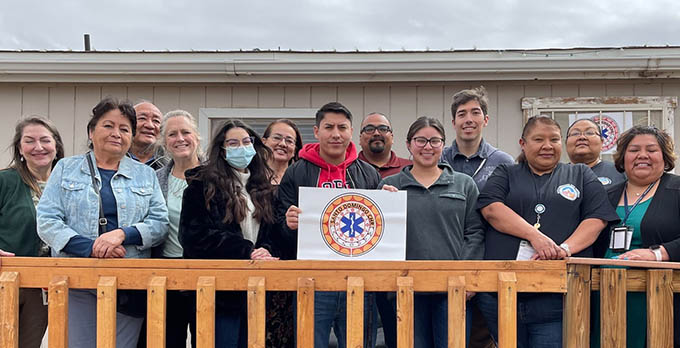Most learners know hands-on experience is one of the best ways to get a well-rounded education.
As for health care students, seeing various environmental conditions firsthand is an invaluable learning opportunity as opposed to – or in addition to – reading about the factors that influence heath care from a textbook.
Reading about the social determinants of health seems very black and white, but those things are just on a page. What the community health representatives are doing here – they see it and face it every day with their community members, and that’s the difference.
“Reading about the social determinants of health seems very black and white, but those things are just on a page,” said Cassandra Acosta, a pre-health scholar certificate program student at The University of New Mexico Health Sciences Rio Rancho campus. “Being with community members is how we can address those social determinants of health.”
To gain some of that real-world experience, Laura Burton, PhD, the pre-health scholar certificate program’s instructor, traveled with students to Santo Domingo Pueblo, also known as Kewa Pueblo, in late March to hear from community health representatives about their work and the assets and challenges that come along with it.
“We’re here learning about the services and the advocacy they do at this clinic for their community,” said student Cassandra Acosta. “It’s given me the opportunity to be shown how important other aspects of community resources are.”
When most people think about health care, they tend to picture doctors and nurses, Acosta said, adding that the field trip opened her eyes to the important services offered by community health workers.
“What we’re learning is that it takes much more support than that,” she said. “We need more support for our doctors and our nurses, and we need more support for our community members, and that’s what these community health workers are here doing. They’re giving all that they have to give back to the community so that their community members can be successful.”
During their presentation, the community health representatives (CHRs) discussed what life was like in the pueblo during the COVID-19 pandemic, how their jobs changed and the challenges they faced.
Under normal circumstances, CHRs visit clients at their homes, deliver medications, educate the community about their health care rights and services available, run vital checks, undertake non-emergency medical transportation, make themselves available for translation services and many more community health services.
“The Santo Domingo CHR program is a general health program at our tribal level to meet the needs of all community members,” said CHR manager Iris Reano. “We never plan our days because I know that every day is going to be different, and we don’t know what calls we’re going to get. Once one of our CHR answers the phone, our day begins.”
But during the pandemic, everything changed.
The CHRs helped with COVID-19 testing, quarantining positive patients, checking vitals, delivering medications, and more. All the employees contracted COVID-19 at one point – and two of them tragically passed away.
“A lot of the work that we’ve done the past three years was frontline work,” Reano said. “We actually lost two CHRs to COVID – both of them worked as CHRs for years. These guys risked their lives.”
The community health representatives also mentioned the social determinants of health, which include environmental conditions in which people are born, live, learn, work, play and worship that affect a wide range of health, functioning and quality-of-life outcomes and risks.
Some of the social determinants at Santo Domingo Pueblo include lack of internet access or technology know-how, language barriers and sacred-held beliefs and traditions that don’t align with “typical” modern-day policies and regulations.
“A lot of people here either don’t have access to the internet or they aren’t computer savvy, so that’s one of the barriers they have,” Reano said. “We listen to everybody and those are the types of things we advocate for.”
According to Acosta, the pre-health scholars certificate program has been helpful and educational in preparing her to pursue a medical degree and eventually becoming a clinician. Specifically, Acosta said the course has taught her about cross-cultural communication and developing soft skills.
“Health communication is really, really important – how we communicate across cultures and how we address that,” she said. “It’s hard to do if you’ve never encountered it. To actually interact is a totally different experience.”
Acosta added that she felt grateful for the learning experience and to be able to be welcomed into the pueblo.
“I’m very thankful for the community health representatives and Santo Domingo Pueblo – the Kewa Pueblo,” she said, “for allowing us to come into their beautiful space and allowing us to see their community.”

